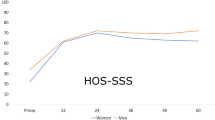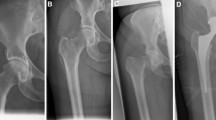Abstract
Introduction
Studies have demonstrated a negative relationship between the length of time with symptoms and patient-reported outcome measures in primary hip arthroscopy. Our aim was to expand the generalizability of this finding with a multi-center cohort.
Methods
A multi-center hip arthroscopy registry was queried for patients undergoing primary hip arthroscopy from 2014 to 2017. Patients were stratified according to whether pre-operative symptom duration exceeded two years or did not exceed two years. A Wilcoxon rank sum test was performed for differences in two year post-operative outcome scores. Logistic regression models analyzed the influence of symptom duration on achieving clinically meaningful thresholds (minimum clinically important difference, patient-acceptable symptom state, substantial clinical benefit) when controlling for baseline scores, age, BMI, and sex.
Results
Seven hundred forty-four patients met the inclusion criteria, from which 620 had complete outcomes information. The mean ± SD 2-year iHOT-12 scores of patients with symptom duration greater than two years (69 ± 26) were significantly lower than patients with symptom duration less than two years (77 ± 23) (Dunn test, p < 0.001). Chronic duration of pain was a negative predictor of achieving iHOT-12 MCID (0.47 [0.31–0.72]), PASS (0.53 [0.37–0.76]), and SCB (0.67 [0.47–0.94]).
Conclusion
When controlling for differences in baseline demographic factors and pre-operative iHOT-12 scores, patients with chronic pain report poorer functional outcomes at mid-term follow-up. These results suggest that chronic pain predicts inferior outcomes from primary hip arthroscopy and that surgical intervention at earlier time points may be beneficial in achieving better outcomes.


Similar content being viewed by others
References
Jamil M, Dandachli W, Noordin S, Witt J (2018) Hip arthroscopy: indications, outcomes and complications. Int J Surg 54(Pt B):341–344. https://doi.org/10.1016/j.ijsu.2017.08.557
Ross JR, Larson CM, Bedi A (2017) Indications for hip arthroscopy Sports health 9(5):402–413. https://doi.org/10.1177/1941738117712675
Trigg SD, Schroeder JD, Hulsopple C (2020) Femoroacetabular impingement syndrome. Curr Sports Med Rep 19(9):360–366. https://doi.org/10.1249/JSR.0000000000000748
Bsat S, Frei H, Beaulé PE (2016) The acetabular labrum: a review of its function. Bone Joint J 98-B(6):730–735. https://doi.org/10.1302/0301-620X.98B6.37099
Su T, Chen GX, Yang L (2019) Diagnosis and treatment of labral tear. Chin Med J 132(2):211–219. https://doi.org/10.1097/CM9.0000000000000020
Kuroda Y, Saito M, Çınar EN, Norrish A, Khanduja V (2020) Patient-related risk factors associated with less favourable outcomes following hip arthroscopy. Bone Joint J 102-B(7):822–831. https://doi.org/10.1302/0301-620X.102B7.BJJ-2020-0031.R1
Griffin DW, Kinnard MJ, Formby PM, McCabe MP, Anderson TD (2017) Outcomes of hip arthroscopy in the older adult: a systematic review of the literature. Am J Sports Med 45(8):1928–1936. https://doi.org/10.1177/0363546516667915
Basques BA, Waterman BR, Ukwuani G, Beck EC, Neal WH, Friel NA, Stone AV, Nho SJ (2019) Preoperative symptom duration is associated with outcomes after hip arthroscopy. Am J Sports Med 47(1):131–137. https://doi.org/10.1177/0363546518808046
Kunze KN, Nwachukwu BU, Beck EC, Chahla J, Gowd AK, Rasio J, Nho SJ (2020) Preoperative duration of symptoms is associated with outcomes 5 years after hip arthroscopy for femoroacetabular impingement syndrome. Arthroscopy 36(4):1022–1029. https://doi.org/10.1016/j.arthro.2019.08.032
Griffin DR, Parsons N, Mohtadi NG, Safran MR (2012) Multicenter arthroscopy of the hip outcomes research network a short version of the international hip outcome tool (iHOT-12) for use in routine clinical practice. Arthroscopy 28(5):611–618. https://doi.org/10.1016/j.arthro.2012.02.027
Martin RL, Kivlan BR, Christoforetti JJ et al (2019) Minimal clinically important difference and substantial clinical benefit values for the 12-item international hip outcome tool. Arthroscopy 35(2):411–416. https://doi.org/10.1016/j.arthro.2018.09.028
Kivlan BR, Martin RL, Christoforetti JJ et al (2019) The patient acceptable symptomatic state of the 12-item international hip outcome tool at 1-year follow-up of hip-preservation surgery. Arthroscopy 35(5):1457–1462. https://doi.org/10.1016/j.arthro.2018.11.072
Robinson PG, Maempel JF, Rankin CS, Gaston P, Hamilton DF (2020) Evaluation of the patient acceptable symptom state following hip arthroscopy using the 12 item international hip outcome tool. BMC Musculoskelet Disord 21(1):5. https://doi.org/10.1186/s12891-019-3026-x
Levy DM, Kuhns BD, Chahal J, Philippon MJ, Kelly BT, Nho SJ (2016) Hip arthroscopy outcomes with respect to patient acceptable symptomatic state and minimal clinically important difference. Arthroscopy 32(9):1877–1886. https://doi.org/10.1016/j.arthro.2016.05.014
Domb BG, Gui C, Lodhia P (2015) How much arthritis is too much for hip arthroscopy: a systematic review. Arthroscopy 31(3):520–529. https://doi.org/10.1016/j.arthro.2014.11.008
Sogbein OA, Shah A, Kay J, Memon M, Simunovic N, Belzile EL, Ayeni OR (2019) Predictors of outcomes after hip arthroscopic surgery for femoroacetabular impingement: a systematic review. Orthop J Sports Med 7(6):2325967119848982
Viswanath A, Khanduja V (2017) Can hip arthroscopy in the presence of arthritis delay the need for hip arthroplasty? J Hip Preserv Surg 4(1):3–8. https://doi.org/10.1093/jhps/hnw050
Dwyer MK, Tumpowsky C, Boone A, Lee J, McCarthy JC (2019) What is the association between articular cartilage damage and subsequent THA 20 years after hip arthroscopy for labral tears? Clin Orthop Reatl Res 477(5):1211–1220. https://doi.org/10.1097/CORR.0000000000000717
Renouf J, Pergaminelis N, Tran P, Fary C, Tirosh O (2019) The outcome of arthroscopic repair of acetabular labral tears using the iHOT-33. BMC Musculoskelet Disord 20(1):210. https://doi.org/10.1186/s12891-019-2611-3
Singh PJ, O’Donnell JM (2010) The outcome of hip arthroscopy in Australian football league players: a review of 27 hips. Arthroscopy 26(6):743–749. https://doi.org/10.1016/j.arthro.2009.10.010
Stake CE, Jackson TJ, Stone JC, Domb BG (2013) Hip arthroscopy for labral tears in workers’ compensation: a matched-pair controlled study. Am J Sports Med 41(10):2302–2307. https://doi.org/10.1177/0363546513496055
Claßen T, Körsmeier K, Kamminga M, Beck S, Rekowski J, Jäger M, Landgraeber S (2016) Is early treatment of cam-type femoroacetabular impingement the key to avoiding associated full thickness isolated chondral defects? Knee surg, sports traumatol, arthrosc 24(7):2332–2337. https://doi.org/10.1007/s00167-014-3332-7
Menge TJ, Briggs KK, Rahl MD, Philippon MJ (2021) Hip arthroscopy for femoroacetabular impingement in adolescents: 10-year patient-reported outcomes. Am J Sports Med 49(1):76–81. https://doi.org/10.1177/0363546520973977
Aprato A, Jayasekera N, Villar R (2012) Timing in hip arthroscopy: does surgical timing change clinical results? Int Orthop 36(11):2231–2234. https://doi.org/10.1007/s00264-012-1655-x
Menge TJ, Briggs KK, Philippon MJ (2016) Predictors of length of career after hip arthroscopy for femoroacetabular impingement in professional hockey players. Am J Sports Med 44(9):2286–2291. https://doi.org/10.1177/0363546516650649
Griffin DR, Dickenson EJ, Wall P, Achana F, Donovan JL, Griffin J, Hobson R, Hutchinson CE, Jepson M, Parsons NR, Petrou S, Realpe A, Smith J, Foster NE, FASHIoN Study Group (2018) Hip arthroscopy versus best conservative care for the treatment of femoroacetabular impingement syndrome (UK FASHIoN): a multicentre randomised controlled trial. Lancet 391(10136):2225–2235. https://doi.org/10.1016/S0140-6736(18)31202-9
Funding
This work was supported by funding from a grant provided by the SICOT Research Academy in 2019.
Author information
Authors and Affiliations
Contributions
All authors made substantial contributions to the conception and design of the study. The first draft of the manuscript was written and prepared by Daniel Shaw. All authors were instrumental in editing and revising the manuscript. All authors approved the current edition of the manuscript for submission.
Corresponding author
Ethics declarations
Ethics approval
This is a retrospective outcomes study. The Institutional Review Board at Piedmont Hospital has confirmed that no ethics approval is required. IRB: Piedmont Healthcare IRB: Atlanta, GA.
Consent to participate
Informed consent was obtained from all participating individuals prior to enrollment in the study registry.
Consent for publication
All participants were informed that their data may be used for the purposes of publication, and they consented to have their data used for this purpose.
Competing interests
Daniel Shaw and Benjamin Kivlan declare that they have no financial interests. Dominic Carreira declares that he has received consulting fees from Zimmer Biomet, Linvatec, and DePuy Orthopaedics and payment for expert opinion from Arthrex Inc., Smith & Nephew, and Wright Medical Technology. Andrew Wolff declares that he has received payment for consulting from Arthrex Inc. and Stryker Corporation. John Christoforetti declares that he has received research funding from Allegheny Singer Research Institute, payment for consulting from Arthrex Inc. and Stryker Corporation, and payment honoraria from Mid-Atlantic Surgical Systems LLC. John Salvo declares that he has received payment for consulting from Stryker Corporation and payment honoraria from Liberty Surgical Inc. Dean Matsuda declares that he has received royalties from Zimmer Biomet and Smith & Nephew and payment for expert testimony from Pacira Pharmaceuticals.
Additional information
Publisher's note
Springer Nature remains neutral with regard to jurisdictional claims in published maps and institutional affiliations.
Rights and permissions
Springer Nature or its licensor holds exclusive rights to this article under a publishing agreement with the author(s) or other rightsholder(s); author self-archiving of the accepted manuscript version of this article is solely governed by the terms of such publishing agreement and applicable law.
About this article
Cite this article
Carreira, D.S., Shaw, D.B., Wolff, A.B. et al. Symptom duration predicts inferior mid-term outcomes following hip arthroscopy. International Orthopaedics (SICOT) 46, 2837–2843 (2022). https://doi.org/10.1007/s00264-022-05579-8
Received:
Accepted:
Published:
Issue Date:
DOI: https://doi.org/10.1007/s00264-022-05579-8




